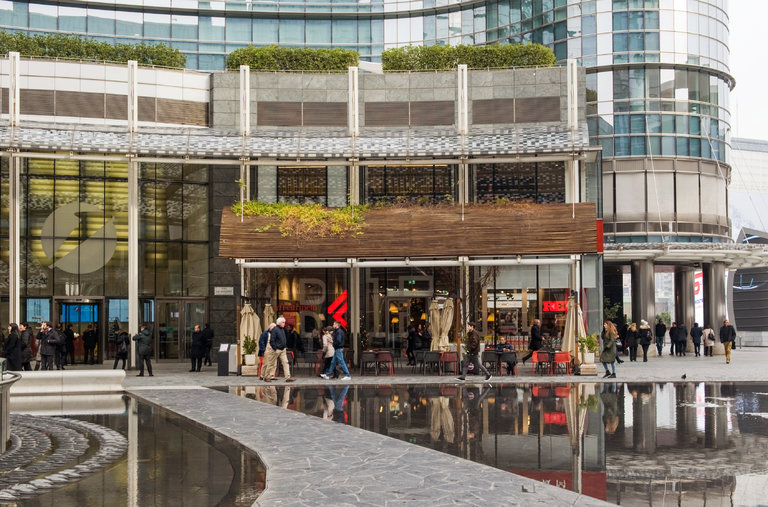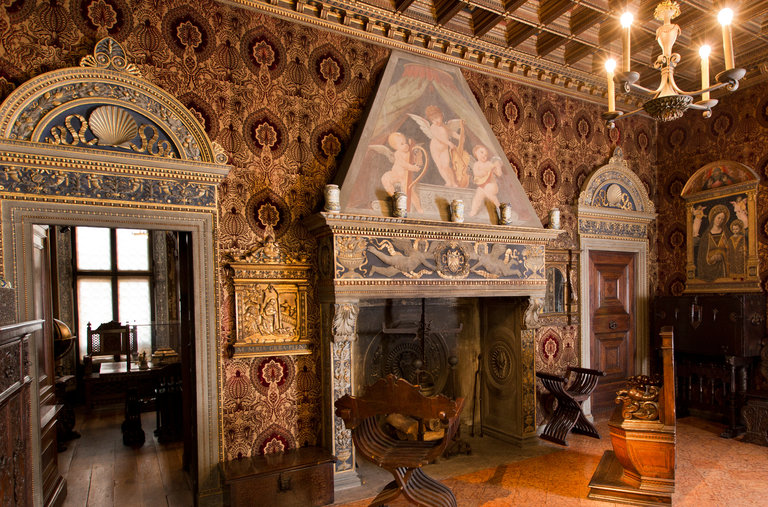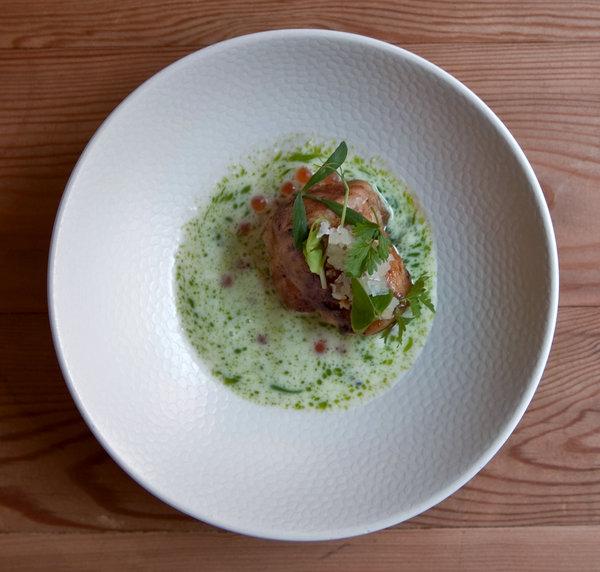More than three years have passed since Milan hosted the 2015 World Expo, a six-month extravaganza that generated more than 20 million visitors, corruption inquiries and a budget that ballooned to some 2 billion euros (or more). So was it worth it? In addition to improving infrastructure, the city used the event to position itself as the gateway to Italy — a destination for more than just fashion, design and business. Visitors today will find cleaned-up canals and restored landmarks, as well as a panoply of projects in peripheral industrial zones that have stretched the city outward. Art and design are still driving forces in Italy’s fashionable second city, but an unlimited transit pass might now be a wiser investment than designer shoes.
Friday
1) 4 p.m. Art start
A five-story building clad in gold leaf welcomes visitors to Fondazione Prada, a new contemporary arts complex as notable for its world-class exhibitions as for its eye-catching architecture. Last year the opening of a nine-story tower marked the completion of the compound, a former distillery redesigned by OMA, the architecture firm co-founded by Rem Koolhaas. Tour the tower’s large-scale artworks — Jeff Koons’s tulips, Walter De Maria’s shiny Bel Airs, Damien Hirst’s disturbing black flies — along with temporary exhibitions, including a multimedia installation from the American artists Lizzie Fitch and Ryan Trecartin (through Aug. 5). Even the on-site cafe, Bar Luce, is worth a look; its retro décor styled by the film director Wes Anderson includes whimsical touches, such as a Steve Zissou-themed pinball machine. Admission, €15, or about $16.70.
2) 6:30 p.m. Alternative aperitivo
Aperitivo is the time to stimulate (yet not sate) the appetite before dinner. For an unconventional take on the tradition, head to Birrificio Italiano Milano, the first bar from an acclaimed microbrewery, which opened in 2017 with beautiful terrazzo floors and a dozen taps. Try the Flos Alba, a barrel-aged sour wheat beer, paired with cicchetti (Venetian tapas), such as bite-size, mortadella-stuffed brioche. Or join the boisterous local crowd at Lacerba, a bar that embodies Italy’s early-20th-century Futurismo movement, from the riotous décor — walls papered with vintage Campari posters, model buses and mini liquor bottles hanging overhead — to the innovative cocktails, such as the Spicy Negroni (mezcal, Campari, gin, vermouth and habanero bitters; €9).
3) 8 p.m. Tripe table
Tripe, horse, snails, spleen and grilled marrow scooped from the bone are all part of the successful formula at Trippa, an outstanding trattoria that opened in 2015. Sociable servers will suggest house specialties like fried tripe — crisp, generously salted and sprinkled with fresh rosemary — but recent highlights also included thick-cut Piedmontese beef tartare and pillowy pumpkin-stuffed tortelli. Reserve online in advance to secure a table in the warm dining room where saffron-yellow walls and dark-wood furnishings give the feel of a decades-old establishment. Dinner for two, about €80.


4) 10 p.m. Culture night
End the evening in Zona Tortona, a former industrial zone where derelict factories have been reclaimed by creative Milanese. After dark, crowds convene at Base, a multipurpose cultural complex that opened in 2016 with art galleries, co-working offices, an artist-in-residence program, performance spaces and art, music and cinema events. Come for the live music, which migrates to the courtyard in warmer months and ranges from jazz jam-sessions and Italian hip-hop to the theatrical song-and-prose performance known as teatro-canzone.

The monkfish at 28 Posti, a socially conscious restaurant notable for its excellent natural wines and the creative cuisine of Marco Ambrosino, a young chef from Procida.CreditAndrea Wyner for The New York Times
Saturday
5) 10 a.m. Morning at the museum
Milan has no shortage of excellent museums, from the Pinacoteca di Brera to the Triennale Design Museum, and the cultural offerings continue to grow. The Museo delle Culture, or Mudec, opened in 2015 in another Zona Tortona industrial complex, which was redesigned by the British architect David Chipperfield. Inside, temporary exhibitions on a wide range of topics — Maori art, Miró, Barbie and Banksy — explore the intersection of art, history and culture. Ascend the black stone staircase to the luminous second-floor atrium to tour the “Storie in Movimento” exhibition about the dual experiences of Peruvians in Milan and of Italians in Peru (through July 14; €14).
6) 1 p.m. Pranzo posti
The story of the innovative bistro 28 Posti begins with inmates from a nearby penitentiary, who handcrafted the wooden cabinets and tables. This socially conscious restaurant is also notable for its excellent natural wines and the creative cuisine of Marco Ambrosino, a young chef from Procida. At lunch, claim one of the 28 seats for a surprise three-course menu (€35), which recently included orbs of squash in fermented-orzo broth; flower-shaped turnips with aromatic herbs and black truffle; and a twist on pizza turca with a lamb-and-sweetbreads filling beneath grilled bread dusted with tarragon.
7) 3 p.m. Historical nexus
A tour of the historic city center may begin on Piazza del Duomo, but it ought not end there. Walk west to Cinque Vie, an intersection of five streets since the Roman era, to explore a labyrinth of narrow, winding lanes that feel more Florentine than Milanese. Once home to traditional craftsmen and artisan studios, the neighborhood has recently evolved into a hub of small galleries, design studios and independent boutiques. One worth seeking out is Wait and See, an exuberant shop founded by Uberta Zambeletti, a stylist with a penchant for unknown designers and colorful textiles, from fuchsia faux-fur coats to rainbow-sequined skirts and sparkly leopard-print trousers.
8) 5:30 p.m. Design drama
Even those unfamiliar with Parisi and Ponti will be impressed by the interior design showroom Nilufar Depot. The industrial space had been intended as storage for Nina Yashar, the city’s pre-eminent gallerist and furniture dealer, but now showcases a museum-like collection of midcentury rarities and contemporary gems. In a dramatic atrium ringed by three stories of black steel balconies, furniture scenes were recently set with pristine Paolo Buffa armchairs from the 1950s, modern brass pendants by Simone Fanciullacci, velvet-wrapped tables, and rare Brazilian wood furnishings by the modernist architect Lina Bo Bardi.
9) 8 p.m. Dinner dance
Not all of Milan is sleek and chic. For proof, find your way to La Balera dell’Ortica, a sprawling dance hall complex on the eastern edge of the city that draws a wide cross-section of locals for dinner, dancing and bocce. The convivial atmosphere and dinner — three courses plus dessert, wine and water for €25 — are reminiscent of the countryside Italian festivals known as sagre. Expect kitschy red velvet curtains, neon disco-ball lighting and long communal tables that quickly fill with multigenerational families, birthday celebrants, and couples young and old. Before long, a cover band will be crooning “Volare, oh oh,” while hipsters and retirees battle for dominance on the adjoining bocce courts. Don’t try to resist the smooth “ballo liscio” music, which in summer lures spinning pairs onto the outdoor dance floor.
10) 11:30 p.m. Riparian revelry
A nightcap in Navigli needn’t involve navigating the crowded bars and cafes that line the neighborhood’s historic canals. A block from the bustle, find Iter, a laid-back cocktail bar that reinvents itself every six months with décor and drinks inspired by the staff’s globe-trotting trips. The most recent destination was Panama — note the hats on the wall — so sample a fresh, fruity cocktail like the Sipu (gin, purple corn, pineapple and lime; €8). Prefer that tipple to-go? Then try Backdoor 43, a 40-square-foot bar nearby where a masked bartender passes take-away drinks, like Il Conte Lucano (amaro, white wine, gin, tea, and bitters; €6), through a small slot window beside the canal.
Sunday
11) 10 a.m. Beans and vines
Fuel up for the day at Orsonero Coffee, a corner caffeteria that opened in 2016, serving velvety cappuccini made with beans from Gardelli, a top Italian roastery. Then proceed to La Vigna di Leonardo, a new museum across from Santa Maria delle Grazie (home of “The Last Supper”) that reveals Leonardo da Vinci’s interest in viticulture. Opened in 2015, the museum invites visitors into Casa Atellani, a residential palazzo dating to the 15th century that was carefully restored by the architect Piero Portaluppi. Audio tours begin in a courtyard with faded 16th-century frescos, and continue through ornate halls into a grassy garden, where Malvasia vines have been replanted on a plot that was once part of da Vinci’s own vineyard, a gift from his patron the Duke of Milan in 1498. Admission, €10.
12) 1 p.m. Market forces
Sunday is market day for vintage and antique hunters, and the best place to unearth treasures is East Market, where hundreds of collectors, designers, artists and artisans regularly gather in a former aeronautics factory. Meet vendors devoted to vinyl, video games, vintage clothes, Italian antiques, modern art and even rare Lego sets. A bar, D.J. and food stalls sustain the energy all afternoon. Dates vary, so check the schedule in advance; on off weekends, the East Market Shop, which opened in November, offers an edited selection from the market’s stalls.
Lodging
Around the corner from the Duomo, Room Mate Giulia is an 85-room hotel that opened in 2016 with playful interiors by the Spanish architect Patricia Urquiola. The design-conscious property offers a cheerful mix of colors and patterns, from the lobby lined with local artworks to rooms outfitted with furniture from Cassina (Via Silvio Pellico 4; room-matehotels.com/giulia; doubles from about €250).
Beside the city’s fashion district, the Senato Hotel is an elegant 43-room boutique property that opened in 2015 in a neoclassical palazzo that was formerly a private family residence. The architect Alessandro Bianchi designed the chic black-and-white interiors, which feature custom furnishings, Carrara-marble bathrooms and gilded ginkgo-leaf light fixtures from the Milanese artisan studio Bottega Gadda (Via Senato 22; senatohotelmilano.it; from €221).
The lively Navigli neighborhood is a good choice for apartment rentals, which start around $70 on Airbnb. And top marks also go to Ostello Bello, a 50-bed hostel near Cinque Vie with some private rooms, lots of free food and social activities (Via Medici 4; ostellobello.com; from about €50).
Follow NY Times Travel on Twitter, Instagram and Facebook. Get weekly updates from our Travel Dispatch newsletter, with tips on traveling smarter, destination coverage and photos from all over the world.






